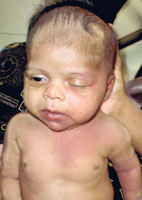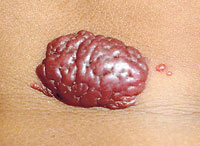Just the word birthmark conjures up visions of a "beauty spot" on someone's face that enhances that person's looks, but what of the red patches that some babies are born with?
 |
| A baby with port-wine stains |
Red patches at birth or vascular birthmarks are a common problem in children, says Consultant Dermatologist Dr. Jayamini Seneviratne who heads the Skin Clinic of the Lady Ridgeway Hospital for Children, explaining that some of these patches are present at birth while others may appear within a month or so after birth.
This time factor, whether the patches were present at birth or developed a few days after the baby was born, is of vital importance in differentiating the types of vascular birthmarks, MediScene understands.
If the patches are present at birth, they have been caused by the malformation of blood vessels – arteries, veins, capillaries – or the lymphatic vessels, says Dr. Seneviratne, adding that those which appear a little later are known as haemangiomas. "There may be a pre-cursor lesion at birth for such haemangiomas which grow rapidly soon after. The positive factor is that they involute or shrink by the time the child reaches the first birthday, although there could be exceptions to this rule," he says.
These patches can occur on any part of the body, it is learnt, with haemangiomas being more common in girls than boys whereas the other conditions occur proportionately in both boys and girls.
Vascular malformations which involve the different types of blood vessels are as follows:
- Arterio-venous malformations or fistulas - these involve arteries and are warmer to the touch, while also being pulsatile.
- Venous malformations - these involve the veins and are large, bumpy lesions.
- Port-wine stains - these involve capillaries.
Arterio-venous and venous malformations and also port-wine stains, especially those occurring on the upper face can have associated problems and may cause brain changes on the side that they are located, says Dr. Seneviratne, explaining that sometimes rarely haemangiomas in the same location can have associated malformations in the heart and the brain. Haemangiomas can grow to a very large size, it is understood.
 |
| Haemangioma |
Vascular malformations grow proportionately as the child grows up and persist into adulthood, according to Dr. Seneviratne.
Dealing with treatment options, he says that for port-wine stains laser treatment is the best while for arterial and venous malformations, surgery remains the only hope.
Haemangiomas, meanwhile, can be treated with drugs, surgery and various injections, though if they are small and not in an important area they can also be left alone.
"How-ever, if the haemangioma is near an eye, ear, on the face or the armpits or close to the groin, you have to be careful about leaving them alone," he adds. |


